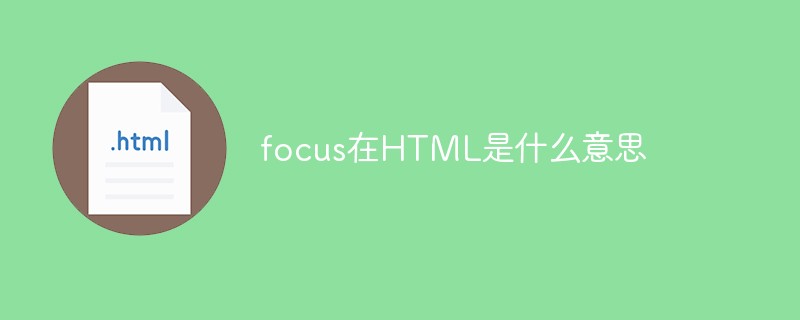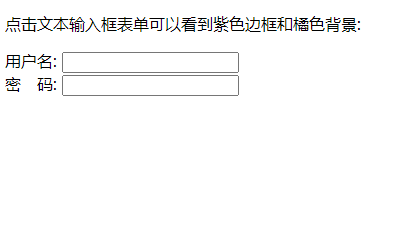What does focus mean in HTML
In HTML, focus means "focus". The ":focus" selector is used to select the element that has received focus. You only need to set the "element:focus{attribute:attribute value}" style to the element. ":focus" is a pseudo-class that applies to an element that has focus. The selector is applied for the time the element has focus.

The operating environment of this tutorial: Windows 7 system, CSS3&&HTML5 version, Dell G3 computer.
:The focus selector is used to select the element that receives focus.
:focus is a pseudo-class that applies to elements that have focus.
:focus applies to the time the element has focus.
The :focus selector can be used as long as it is an element that can receive keyboard events or other user input. In most cases, the :focus selector is used on links and form elements.
Example:
a:focus {outline: 1px dotted red;}
input:focus {background: yellow;}Note: :focus works on IE8, DOCTYPE must be declared
Example:
<!DOCTYPE html>
<html>
<head>
<meta charset="utf-8" />
<style>
input:focus {
outline: 0;
/* 去除浏览器默认样式 */
border: 2px solid rgb(238, 175, 238);
background-color: rgb(255, 230, 192);
text-shadow: 1px 1px saddlebrown;
}
</style>
</head>
<body>
<p>点击文本输入框表单可以看到紫色边框和橘色背景:</p>
<form>
用户名: <input type="text" name="username" /><br />
密 码: <input type="password" name="password" />
</form>
</body>
</html>Rendering:

Note:
Under normal circumstances, the browser will automatically add an outline around the element when the form element gets focus. The style added by the browser is unique to each browser. Default styles, and often times, default styles look different between each browser.
But for the overall beauty of the page and browser style compatibility, we often need to modify the element style when it gets focus and replace the default style with our own style.
At this time we can use the css :focus selector to set the default style of the element when the browser gets focus.
Recommended learning: html video tutorial
The above is the detailed content of What does focus mean in HTML. For more information, please follow other related articles on the PHP Chinese website!

Hot AI Tools

Undresser.AI Undress
AI-powered app for creating realistic nude photos

AI Clothes Remover
Online AI tool for removing clothes from photos.

Undress AI Tool
Undress images for free

Clothoff.io
AI clothes remover

AI Hentai Generator
Generate AI Hentai for free.

Hot Article

Hot Tools

Notepad++7.3.1
Easy-to-use and free code editor

SublimeText3 Chinese version
Chinese version, very easy to use

Zend Studio 13.0.1
Powerful PHP integrated development environment

Dreamweaver CS6
Visual web development tools

SublimeText3 Mac version
God-level code editing software (SublimeText3)

Hot Topics
 1378
1378
 52
52
 Table Border in HTML
Sep 04, 2024 pm 04:49 PM
Table Border in HTML
Sep 04, 2024 pm 04:49 PM
Guide to Table Border in HTML. Here we discuss multiple ways for defining table-border with examples of the Table Border in HTML.
 HTML margin-left
Sep 04, 2024 pm 04:48 PM
HTML margin-left
Sep 04, 2024 pm 04:48 PM
Guide to HTML margin-left. Here we discuss a brief overview on HTML margin-left and its Examples along with its Code Implementation.
 Nested Table in HTML
Sep 04, 2024 pm 04:49 PM
Nested Table in HTML
Sep 04, 2024 pm 04:49 PM
This is a guide to Nested Table in HTML. Here we discuss how to create a table within the table along with the respective examples.
 HTML Table Layout
Sep 04, 2024 pm 04:54 PM
HTML Table Layout
Sep 04, 2024 pm 04:54 PM
Guide to HTML Table Layout. Here we discuss the Values of HTML Table Layout along with the examples and outputs n detail.
 HTML Input Placeholder
Sep 04, 2024 pm 04:54 PM
HTML Input Placeholder
Sep 04, 2024 pm 04:54 PM
Guide to HTML Input Placeholder. Here we discuss the Examples of HTML Input Placeholder along with the codes and outputs.
 HTML Ordered List
Sep 04, 2024 pm 04:43 PM
HTML Ordered List
Sep 04, 2024 pm 04:43 PM
Guide to the HTML Ordered List. Here we also discuss introduction of HTML Ordered list and types along with their example respectively
 Moving Text in HTML
Sep 04, 2024 pm 04:45 PM
Moving Text in HTML
Sep 04, 2024 pm 04:45 PM
Guide to Moving Text in HTML. Here we discuss an introduction, how marquee tag work with syntax and examples to implement.
 HTML onclick Button
Sep 04, 2024 pm 04:49 PM
HTML onclick Button
Sep 04, 2024 pm 04:49 PM
Guide to HTML onclick Button. Here we discuss their introduction, working, examples and onclick Event in various events respectively.




